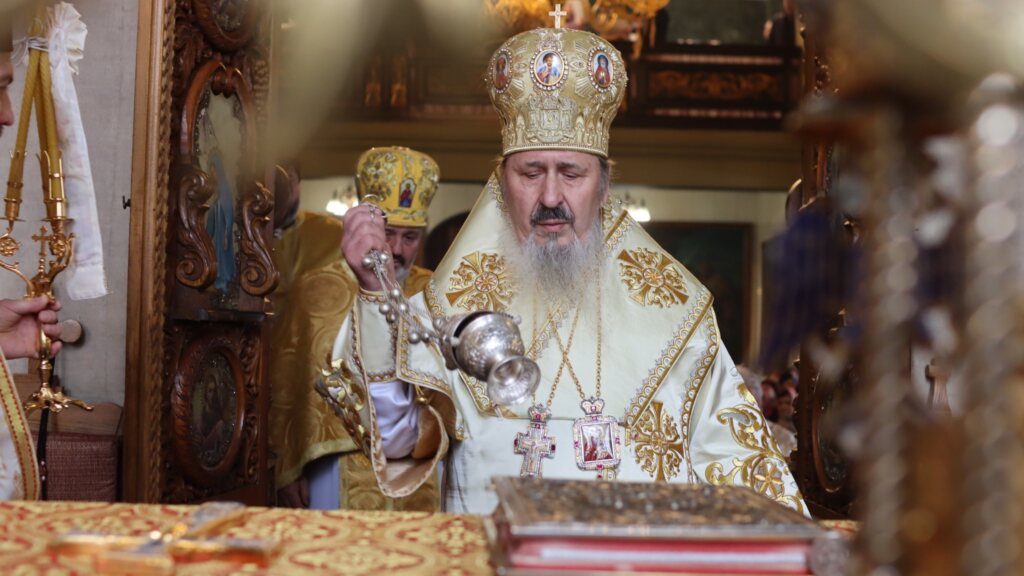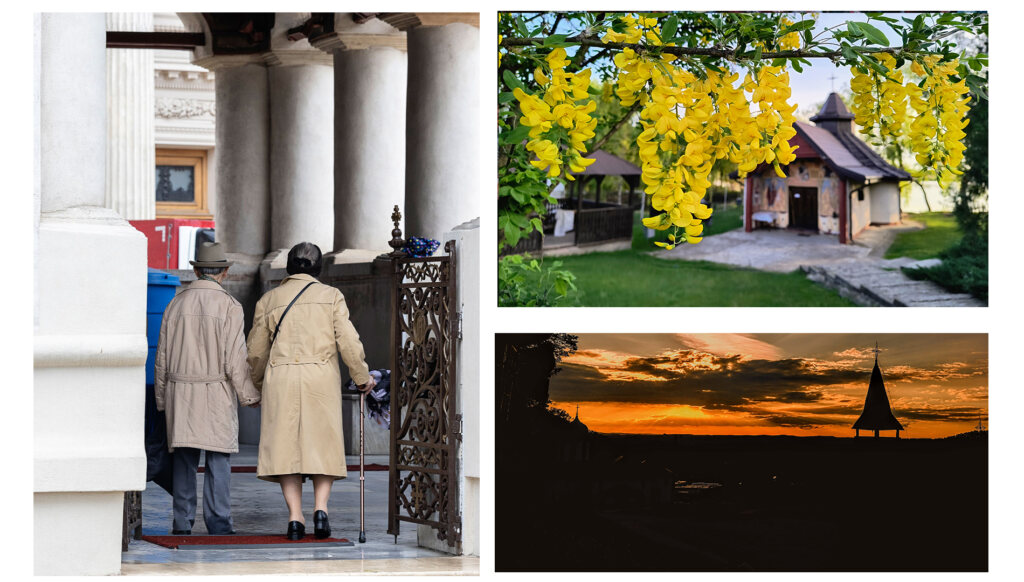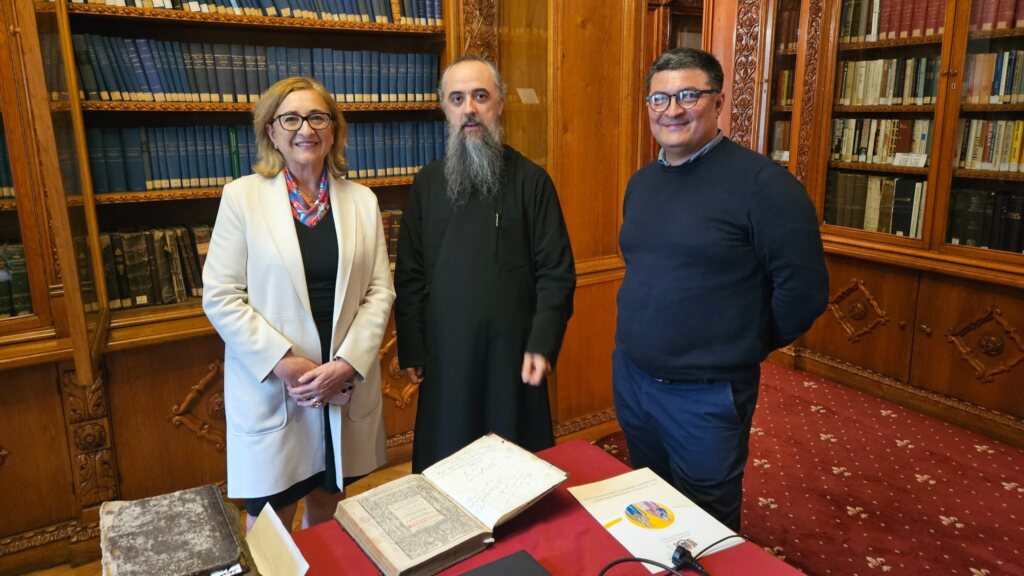“Christ’s Nativity unites heaven and earth” is the title of this year’s Christmas encyclical of His Beatitude Patriarch Daniel of Romania.
In his pastoral letter addressed to the plenitude of the Romanian Orthodox Church, Patriarch Daniel stresses that “the Son of God, Jesus Christ, descends into the world to be born, to grow and to save us, to reconcile us with God (2 Corinthians 5:18-19), thus uniting heaven and earth.”
“In this sense, the gift of the peace of the soul or the reconciliation of man with God, with himself and his neighbours, is requested through prayer and is cultivated through good thoughts, words and deeds so that the inner peace of the soul becomes a source of social peace, peace in the family, in the community and the world,” His Beatitude noted.
Patriarch Daniel used his Christmas encyclical to urge people to “ show merciful love and solidarity towards all people, but especially towards those who suffer because of the war.”
Please find below the full text of the pastoral letter of His Beatitude Patriarch Daniel of Romania on the feast of the Nativity of our Lord Jesus Christ 2022:
Pastoral letter on the Feast of the Nativity of the Lord 2022: Christ’s Nativity unites heaven and earth
† DANIEL
By God’s Grace,
Archbishop of Bucharest,
Metropolitan of Muntenia and Dobruja,
Locum tenens of the throne of Caesarea of Cappadocia
and
Patriarch of the Romanian Orthodox Church
To the most venerable monastic order, The most reverend clergy
And the Orthodox Christians in the Archdiocese of Bucharest
Grace, peace and joy from our Lord Jesus Christ,
And paternal blessings on our behalf!
“Glory to God in the highest heaven,
and on earth peace, goodwill toward men.” (Luke 2:14)
Very Reverend Fathers,
Beloved brothers and sisters in the Lord,
In the Orthodox Creed, we confess our faith “in one God, Father Almighty, Creator of heaven and earth, and of all things visible and invisible,” our faith “in one Lord Jesus Christ, the only-begotten Son of God, […] begotten, not created, of one essence with the Father through Whom all things were made,” and our faith “in the Holy Spirit, the Lord, the Creator of life.”
Therefore, the created world is the joint work of the Holy Trinity. Although, each Person of the Holy Trinity participates in Their way to the world’s creation. God the Father creates the world through the Son and the Holy Spirit.
Thus, we read in Psalm 33, “By the word of the Lord the heavens were made, and all the host of them by the breath of His mouth.” Saint Basil the Great explains this verse: “The word is the Word Who was in the beginning with God (John 1:2) […], and the Holy Spirit is the breath of His mouth.”
The New Testament indicates that the mystery of the Incarnation of Christ confirms a special bond between the Son of God and creation because the Incarnation of the Son of God is the purpose of the world’s creation itself (Ephesians 1:4; 2 Timothy 1:9).
In his epistle to the Colossians, Saint Paul highlights even more precisely the relation the Son of God has with the visible and invisible world: “Giving thanks to the Father who has qualified us to be partakers of the inheritance of the saints in the light. He has delivered us from the power of darkness and conveyed us into the kingdom of the Son of His love, in whom we have redemption through His blood, the forgiveness of sins. He is the image of the invisible God, the firstborn of all creation. For by Him all things were created that are in heaven and that are on earth, visible and invisible, whether thrones or dominions or principalities or powers. All things were created through Him and for Him. And He is before all things, and in Him, all things consist. And He is the head of the body, the church, who is the beginning, the firstborn from the dead, that in all things He may have the preeminence.” (Colossians 1:12-18)
So, the Holy Apostle Paul affirms that the eternal Son of the Father “is the image of the invisible God, the firstborn over all creation. For by Him all things were created.” This means that the Son has the vocation to preach and reveal the Father’s initiative, will and love to the created world.
However, the Son of God, “the firstborn over all creation,” is not a creature. On the contrary, he is the eternal Son born of the Father before all ages, which means uncreated and preexisting before the entire visible and invisible creation.
The fact that “all things were created through Him and for Him” means that although the created world is different from the eternal Son, it is inseparable from the Son. Why? Because God the Father decided to create the visible and invisible world for the Son.
The world is God’s gift for the Son because, in the plan of God the Father, the Son incarnate would show God’s love for the world (John 3:16). The world was created through the Son because the Son would come into the world and live in it as God-Man to renew and sanctify it from within, beginning from the Virgin’s womb, from the cave of the earth and from within the waters of Jordan River.
If through its creation, the world is placed spiritually (according to grace) in the Son, through His incarnation, the Son lives physically in the world until His ascension with the body in glory into heaven.
Therefore, the Son’s relationship with the created world contains His vocation to show humans the love of the Father for the world and to invite the world to love the Father to gain eternal life (John 3:16).
Furthermore, the world created in the Son – the image of the invisible God – has its own vocation to become for humankind the visible expression of the Father’s love for the Son and the Son’s love for the Father. Thus, from its beginnings, the created world is called to become man’s gift or offering of thanksgiving to God, to become a eucharist.
By the very fact that it was created in the Son – the Image or Icon of the invisible God – the world has a symbolic and iconic vocation: that of signifying or suggesting the mystery of the presence and work of the invisible Creator in the visible created world. The psalmist testifies to this truth: “The heavens declare the glory of God; the skies proclaim the work of his hands” (Psalm 19: 1).
The apostle to the Gentiles adds: “God’s invisible qualities—his eternal power and divine nature—have been clearly seen, being understood from what has been made” (Romans 1:20).
Of course, the created world is not God, but is His work, inseparable from Him and maintained in existence by Him (Acts 17: 28). The world is different from God because it is a created reality, but God is uncreated.
Although distinct from God, the world nevertheless has its origin in the creative will of God, and its finality is participation in the glory of God, that is, the transfiguration of the created universe into a new heaven and a new earth penetrated by the eternal, uncreated light of God (Revelation 21: 1-6).
The world created in the Son – the Image or Icon of the invisible God – is at the same time the world made in the Son the Logos or Word of God (John 1: 1-3). Thus, in Jesus Christ, the mystery of the Word is united with the mystery of the Image or the mystery of the Icon.
Therefore, the created world carries within it the vocation of being a symbolic language as a gift of the invisible God both for His Son and the visible human persons, created in the image of the eternal Son of the Father.
Hence, all the laws and lights of the created world, seen or unseen, are a mysterious, iconic and symbolic language supported by the divine Person of the Son – the Logos Creator, the Word or Reason and Icon or Image of the invisible God.
However, both the perception and understanding of this iconic language is achieved only through the grace of the Holy Spirit, who proceeds from the Father (John 15: 26), rests in the Son (Mark 1: 10-11), proves or confirms the communion of love of the Father with the Son (John 14:11; 15:26; 16: 13; 1 Corinthians 2: 10) and directs the creature towards its Creator (1 Corinthians 6: 19; Galatians 4: 6).
Church theologians in the first centuries noted that the Son is the Image of the invisible God, while man is the image of the Image, that is, the Eternal Son of the Father is the prototype after which man was created [2]. So, man is an image created after the uncreated Image of the Son.
The Son is the uncreated Image of God the Father, and man is created in the image of the eternal Son, who would become man through his incarnation.
In this regard, Saint Athanasius the Great says that the Son of God only “is Image true and natural of the Father. For though we have been made after the Image, and called both image and glory of God, yet not on our own account still, but for that Image and true Glory of God inhabiting us, which is His Word, who was for us afterwards made flesh, have we this grace of our designation. [Discourse 3 Against the Arians, 25:10]
At the same time, man was made in the image of the Holy Trinity. The mysterious plural “Let us make mankind in our image, in our likeness” (Genesis 1: 26) was explained by the Church Fathers as an active presence of the Holy Trinity in the creation of man.
More precisely, man was created in the image of the eternal communion of the Father, the Son and the Holy Spirit to proclaim and praise the love of the Holy Trinity in the created world and to live in communion of love with God and with fellow men. “The words let us make are used for you to recognise the Father, the Son and the Holy Spirit,” says Saint Basil the Great.
The fine distinction between image and likeness made by some Fathers of the Church shows the importance of man’s freedom in perfecting his communion with God and his neighbours.
“Let’s make man in Our image and likeness”. We possess one (image) through creation and reach the other (likeness) through will […]. In reality, He (God) gave us through creation the possibility of likeness […]. By image, I am a spiritual being, but becoming a Christian, I am according to the likeness.”
Created in the image of the eternal God, man is called to acquire the likeness of the holy God, that is, holiness and eternal life through free communion with God.
“For the glory of God,” Saint Irenaeus of Lyon wrote, “is a living man; and the life of man consists in beholding God.” (Against Heresies IV, 20: 7)
If man’s free communion with God is essential to acquire the likeness of God, that is, holiness and eternal life, the breaking of communion with God through the sin of disobedience to God led man to death and decay (corruption), which are contrary to the vocation of man created in the image of the living God (Genesis 3: 19; Romans 6: 23; 1 Corinthians 15: 21-22).
For this reason, the New Testament does not consider human death a natural phenomenon but an enemy of man, from which Christ frees us through complete obedience to God on the Cross and through His Resurrection (1 Corinthians 15: 26; Revelation 21: 4). Likewise, the entire corrupt creation “will be liberated from its bondage to decay and brought into the freedom and glory of the children of God” (Romans 8:21).
Beloved spiritual sons and daughters,
Showing the overwhelming purpose and importance of the Incarnation and Birth of Christ as a man, Saint Maximos the Confessor says:
Christ “is the great and hidden mystery. This is the blessed end for which all things were brought into existence… And this is because it is for the sake of Christ – that is, for the whole mystery of Christ – that all the ages and the beings existing within those ages received their beginning and end in Christ. For the union of the limit of the age and limitlessness, of measure and immeasurability, of finitude and infinity, of Creator and creation, and of rest and motion, was conceived before the ages. This union has been manifested in Christ at the end of time and through itself bestows the fulfillment of God’s foreknowledge […]” (Responses to Thalassios 60)
Man’s salvation means being healed from sin and death and participating in the eternal divine life.
Saint Irenaeus of Lyon thus expresses the purpose of the Incarnation of Christ: “For it was for this end that the Word of God was made man, and He who was the Son of God became the Son of man, that man, having been taken into the Word, and receiving the adoption, might become the son of God.” (Against Heresies, III, 19:1).
Therefore, the Son of God, Jesus Christ, descends into the world to be born, to grow and to save us, to reconcile us with God (2 Corinthians 5:18-19), thus uniting heaven and earth.
In this sense, the gift of the peace of the soul or the reconciliation of man with God, with himself and his neighbours, is requested through prayer and is cultivated through good thoughts, words and deeds so that the inner peace of the soul becomes a source of social peace, peace in the family, in the community and the world.
The Holy Fathers of the Church teach us that selfish passions, such as greed or the obsessive love of wealth, power and pleasure and the like, produce disorder in the soul. This disorder then spills over into relationships between people, which become tense, conflictual and even violent, mainly because of the injustices and sufferings created by greed or the desire of some nations to rule over other peoples.
When selfish passions darken human thinking, it produces disorder and much evil in the soul and society. Instead, the wisdom that comes from God “is first of all pure; then peace-loving, considerate, submissive, full of mercy and good fruit, impartial and sincere. Peacemakers who sow in peace reap a harvest of righteousness” (James 3: 17-18).
And this peaceful wisdom is acquired above all through the humble and unceasing prayer of the mind and heart, as the Holy Apostles and the Holy Hesychast Fathers in the history of the Church teach us.
Right-believing Christians,
The Holy Synod of the Romanian Orthodox Church declared the year 2023 as a Solemn Year of Pastoral Care of the Elderly and the Commemorative Year of Hymnographers and Church chanters.
As in previous years, at the end of the year, i.e. on the night of December 31, 2022, to January 1, 2023, and on New Year’s Day, let us offer prayers of thanksgiving to God for the benefits received from Him in the year 2022 that has passed and let us ask for His help in all the good and useful work in the New Year 2023 we are entering.
Let us also remember in our prayers all the Romanians outside Romania, those around Romania’s borders and those in the Romanian diaspora so that we can preserve, with much brotherly love, the unity of faith and nation.
Let us cultivate the peace of our hearts received from Christ through prayer and good deeds and pray for peace between nations.
Let us show merciful love and solidarity towards all people, especially those suffering from the war. Let us bring the joy of the Feast of the Nativity of our Lord Jesus Christ to the homes of orphaned children, to retirement homes, to the bedside of the sick, but also where there is much sadness, loneliness and depression, in poor, bereaved and grieving families. Wherever we can do good, let us do it bearing in our souls and deeds the joy of the angels, the shepherds and the magi who came to Bethlehem!
On the Holy Feasts of the Nativity of the Lord, the New Year 2023, and the Baptism of the Lord, we convey to you all our paternal blessings, wishes for good health and salvation, peace and joy, happiness and much help from God in all good deeds, along with the traditional greeting: “Happy New Year!”
“May the grace of the Lord Jesus Christ, and the love of God, and the fellowship of the Holy Spirit be with you all” (2 Corinthians 13:14).
Your fervent supplicant to Christ the Lord,
† Daniel
Patriarch of the Romanian Orthodox Church
Follow us on Twitter: @BasilicaNews






